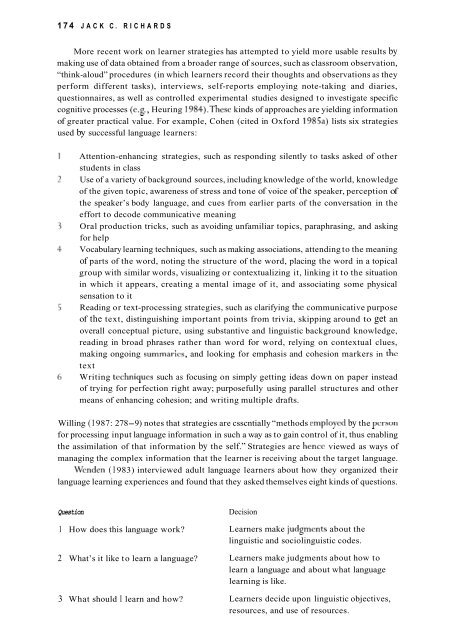English Language Teaching in its Social Context
English Language Teaching in its Social Context
English Language Teaching in its Social Context
You also want an ePaper? Increase the reach of your titles
YUMPU automatically turns print PDFs into web optimized ePapers that Google loves.
174 JACK C. RICHARDSMore recent work on learner strategies has attempted to yield more usable results bymak<strong>in</strong>g use of data obta<strong>in</strong>ed from a broader range of sources, such as classroom observation,“th<strong>in</strong>k-aloud” procedures (<strong>in</strong> which learners record their thoughts and observations as theyperform different tasks), <strong>in</strong>terviews, self-reports employ<strong>in</strong>g note-tak<strong>in</strong>g and diaries,questionnaires, as well as controlled experimental studies designed to <strong>in</strong>vestigate specificcognitive processes (e.g., Heur<strong>in</strong>g 1984).These k<strong>in</strong>ds of approaches are yield<strong>in</strong>g <strong>in</strong>formationof greater practical value. For example, Cohen (cited <strong>in</strong> Oxford 1985a) lists six strategiesused by successful language learners:Attention-enhanc<strong>in</strong>g strategies, such as respond<strong>in</strong>g silently to tasks asked of otherstudents <strong>in</strong> classUse of a variety of background sources, <strong>in</strong>clud<strong>in</strong>g knowledge of the world, knowledgeof the given topic, awareness of stress and tone of voice of the speaker, perception ofthe speaker’s body language, and cues from earlier parts of the conversation <strong>in</strong> theeffort to decode communicative mean<strong>in</strong>gOral production tricks, such as avoid<strong>in</strong>g unfamiliar topics, paraphras<strong>in</strong>g, and ask<strong>in</strong>gfor helpVocabulary learn<strong>in</strong>g techniques, such as mak<strong>in</strong>g associations, attend<strong>in</strong>g to the mean<strong>in</strong>gof parts of the word, not<strong>in</strong>g the structure of the word, plac<strong>in</strong>g the word <strong>in</strong> a topicalgroup with similar words, visualiz<strong>in</strong>g or contextualiz<strong>in</strong>g it, l<strong>in</strong>k<strong>in</strong>g it to the situation<strong>in</strong> which it appears, creat<strong>in</strong>g a mental image of it, and associat<strong>in</strong>g some physicalsensation to itRead<strong>in</strong>g or text-process<strong>in</strong>g strategies, such as clarify<strong>in</strong>g the communicative purposeof the text, dist<strong>in</strong>guish<strong>in</strong>g important po<strong>in</strong>ts from trivia, skipp<strong>in</strong>g around to get anoverall conceptual picture, us<strong>in</strong>g substantive and l<strong>in</strong>guistic background knowledge,read<strong>in</strong>g <strong>in</strong> broad phrases rather than word for word, rely<strong>in</strong>g on contextual clues,mak<strong>in</strong>g ongo<strong>in</strong>g summaries, and look<strong>in</strong>g for emphasis and cohesion markers <strong>in</strong> thctextWrit<strong>in</strong>g tcchniques such as focus<strong>in</strong>g on simply gett<strong>in</strong>g ideas down on paper <strong>in</strong>steadof try<strong>in</strong>g for perfection right away; purposefully us<strong>in</strong>g parallel structures and othermeans of enhanc<strong>in</strong>g cohesion; and writ<strong>in</strong>g multiple drafts.Will<strong>in</strong>g (1 987: 278-9) notes that strategies are csscntially “methods employcd by the pcrsonfor process<strong>in</strong>g <strong>in</strong>put language <strong>in</strong>formation <strong>in</strong> such a way as to ga<strong>in</strong> control of it, thus enabl<strong>in</strong>gthe assimilation of that <strong>in</strong>formation by the self.” Strategies are hence viewed as ways ofmanag<strong>in</strong>g the complex <strong>in</strong>formation that the learner is receiv<strong>in</strong>g about the target language.Wenden (1 983) <strong>in</strong>terviewed adult language learners about how they organized theirlanguage learn<strong>in</strong>g experiences and found that they asked themselves eight k<strong>in</strong>ds of questions.QuestionDecision1 How does this language work? Learners make judgmcnts about thel<strong>in</strong>guistic and sociol<strong>in</strong>guistic codes.2 What’s it like to learn a language?3 What should I learn and how?Learners make judgments about how tolearn a language and about what languagelearn<strong>in</strong>g is like.Learners decide upon l<strong>in</strong>guistic objectives,resources, and use of resources.












